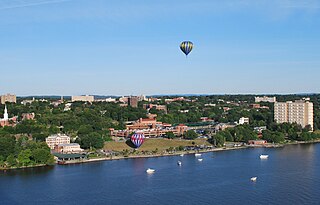
Poughkeepsie, officially the City of Poughkeepsie, which is separate from the Town of Poughkeepsie around it, is a city in the U.S. state of New York. It is the county seat of Dutchess County, with a 2020 census population of 31,577. Poughkeepsie is in the Hudson River Valley region, midway between the core of the New York metropolitan area and the state capital of Albany. It is a principal city of the Kiryas Joel–Poughkeepsie–Newburgh metropolitan area which belongs to the New York combined statistical area. It is served by the nearby Hudson Valley Regional Airport and Stewart International Airport in Orange County, New York.

Poughkeepsie, officially the Town of Poughkeepsie, is a town in Dutchess County, New York, United States. As of the 2020 United States Census, the population was 45,471. The name is derived from the native compound Uppuqui-ipis-ing, from Uppuqui meaning "lodge-covered", plus ipis meaning "little water", plus ing meaning "place", all of which translates to "the reed-covered lodge by the little water place". This later evolved into Apokeepsing, then into Poughkeepsing, and finally Poughkeepsie.

A townhouse, townhome, town house, or town home, is a type of terraced housing. A modern townhouse is often one with a small footprint on multiple floors. In a different British usage, the term originally referred to any type of city residence of someone whose main or largest residence was a country house.

A terrace, terraced house (UK), or townhouse (US) is a kind of medium-density housing that first started in 16th century Europe with a row of joined houses sharing side walls. In the United States and Canada these are sometimes known as row houses or row homes.

The Walkway over the Hudson is a steel cantilever bridge spanning the Hudson River between Poughkeepsie, New York, on the east bank and Highland, New York, on the west bank. Built as a double track railroad bridge, it was completed on January 1, 1889, and formed part of the Maybrook Railroad Line of the New York, New Haven and Hartford Railroad.
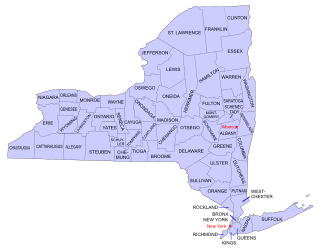
Buildings, sites, districts, and objects in New York listed on the National Register of Historic Places:

Union Square is a neighborhood located in the Sowebo area of Baltimore. It dates to the 1830s and includes a historic district of houses and commerce buildings.
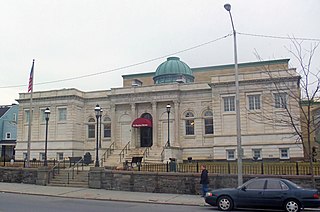
The Adriance Memorial Library is located on Market Street in Poughkeepsie, New York, United States. It is a stone building in the Classical Revival architectural style erected shortly at the end of the 19th century. In 1982 it was listed on the National Register of Historic Places.

The Clinton House is an 18th-century Georgian stone building in the city of Poughkeepsie, Dutchess County, New York, United States. It is a New York State Historic Site and has been listed in the National Register of Historic Places as a historic place of local significance since 1982. The house was named for George Clinton, who served as the first Governor of New York and fourth Vice-President of the United States. He was believed to have lived there after the American Revolutionary War, but it is now known that it was never his residence.

The U.S. Post Office in Rhinebeck, New York serves the 12572 ZIP Code. It is located on Mill Street just south of the intersection with NY 308 at the center of the village.

The Old Poughkeepsie YMCA is on the west side of Market Street near the corner of Church Street in Poughkeepsie in New York, United States, across from the former New York State Armory. One of many historic early 20th-century institutional buildings on Market Street, the city's main downtown thoroughfare, it has a glazed terra-cotta front facade, the only building in Poughkeepsie using that material.

Harlow Row, also called Brick Row, is a group of brick townhouses in Poughkeepsie, New York, United States. While their address is given as 100-106 Market Street, they are actually located on a short side street referred to as Little Market Street, across from a small park with the Soldiers' and Sailors' Memorial Fountain, on the residential southern fringe of the city's downtown.

Ednor Gardens-Lakeside is a large community in northeast Baltimore, Maryland. It is bounded by 33rd Street to the south, Hillen Road to the east, Ellerslie Avenue to the west, and Argonne Drive, The Alameda, Loch Raven Boulevard, and Roundhill Road to the north. Ednor Gardens was part of a large planned community that was built out from the 1920s through the 1950s by Edward Gallagher, one of Baltimore's most prolific homebuilders at the time. It is notable among its neighbors for the quality of the homes and extensive landscaping. Until it was torn down in 2002, Memorial Stadium was located in Ednor Gardens-Lakeside.

The Mill Street–North Clover Street Historic District is located along those streets and Main Street in western Poughkeepsie, New York, United States. It is an irregularly-shaped area of 27 acres (11 ha) between US 9 and downtown Poughkeepsie, located on the slope up from the Hudson River. There are roughly 139 historic buildings, and very few new ones.

Buildings at 10, 12, 14, and 16 East Chase Street is a historic set of rowhouses located at Baltimore, Maryland, United States. Number 10 is a 3+1⁄2-story brick townhouse with a 3-bay front façade, fitted with marble facing from ground to first floor level. It is believed to have been designed by Bruce Price and / or E. Francis Baldwin, architects of neighboring Christ Church. Numbers 12, 14, and 16, by contrast, are identical 3+1⁄2-story, two-bay houses constructed of green serpentine marble with contrasting stone detail. The group dates from between 1870 and 1875. They represent a fine example of the Gothic Revival style as interpreted for domestic architecture.

Creek Meeting House and Friends' Cemetery is a historic Society of Friends meeting house and cemetery on Salt Point Turnpike/Main Street in Clinton Corners, Dutchess County, New York, United States. It was built between 1777 and 1782. The meeting house is a two-story, squarish building constructed of fieldstone. Land for the building was given by Able Peters, whose substantial brick house is the next building on the same side of the road north of the meeting house. In 1828 the Friends Creek Meeting split into Hicksite and Orthodox meetings. The Orthodox meeting moved about a mile north of Clinton Corners to the Shingle Meeting House located on the grounds of the current Friends Upton Lake Cemetery. The Creek Meeting sold the building to the Upton Lake Grange in 1927 and joined the Bulls Head Meeting in 1936.
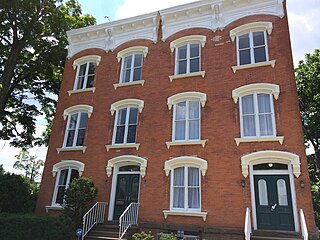
The Boughton-Haight House is a historic house located at 73-75 South Hamilton Street in Poughkeepsie, Dutchess County, New York.
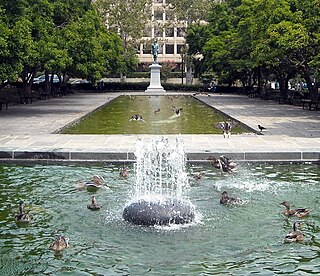
Rawlins Park is a rectangular public park in the Foggy Bottom neighborhood of Washington, D.C., two blocks west of the White House grounds and two blocks north of the National Mall. The boundaries of the park are 18th Street NW to the east, E Street NW to the south and north, and 19th Street NW to the west. The park was an undeveloped open space for many years, until plans were made to install the statue of John Aaron Rawlins in 1874. Various improvements were made, but the area surrounding the park remained mostly undeveloped. This changed in the 1890s when the area was cleared of marshes, and houses were built on the park's southern border.
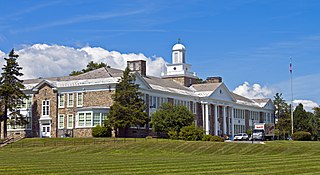
Violet Avenue School is a historic school building located at Poughkeepsie, Dutchess County, New York. It was built in 1939–1940, and is a two-story, five part, Colonial Revival style school building with load-bearing bluestone walls. It consists of a central tetrastyle portico entry block flanked by four wings. The central section features a central two-story classical portico with four columns with Corinthian order capitals and a prominent domed cupola. The school was built under the auspices of the Public Works Administration and President Franklin Delano Roosevelt was influential in the design.

Pearson Terrace is a historic rowhouse block in Indianapolis, Indiana. It was built in 1901–1902, and is a two-story, seven unit, vernacular Queen Anne style grey brick row with limestone trim. It sits on a raised basement and has a complex gable roof. It features a projecting two bay center unit and projecting window bay.
























